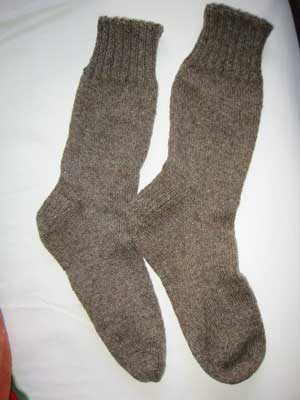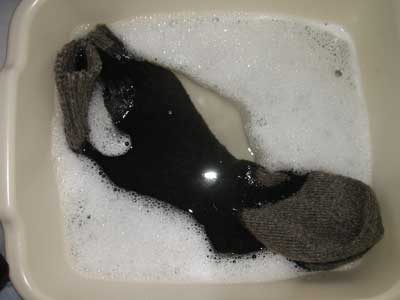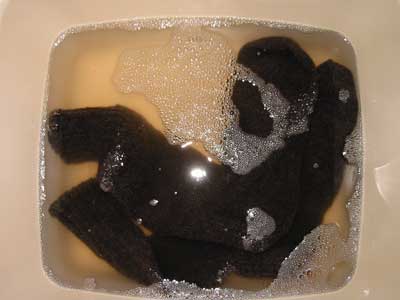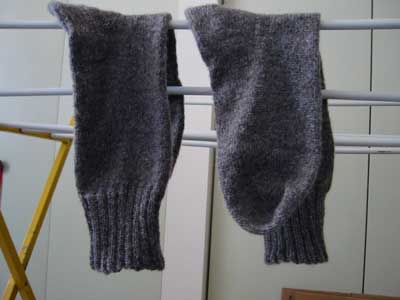Yesterday evening I wove together the toe of the first sock but I waited until this morning for better light to weave the second toe and bind in the ends.
Like for the first sock, I broke the yarn and left a very long end then wove the toe loosely. I then put my left hand into the sock and used the tapestry needle to tighten each knit stitch. Like magic, the loose stitches melt into the ones I knit on the needles.
This leaves binding in the ends. For the toes, I thread the end onto the needle again and poke through as close as I can to the last stitch then pull the thread through to the outside. I then insert my hand and turn the sock inside out. I pull through the loop of exposed thread from the toe, thread it through the tapestry needle again, and work it into the stitches following the path of a thread.
For the cast on edge at the cuff, still working from the inside, I do a few stitches to make the joining less obvious, then work my way to the right knit edge of the closest rib, then sew overhand making a corded edge that melts into the vertical line of knit stitches. While the sock is inside out, check the three-way corner of the gusset where the heel flap meets the picked up edge and the cuff. Mine look OK, but had there been a gap, I would have taken another piece of yarn and sewed them shut then bound in the ends like for where yarn is joined.
I then turn the socks right side out:

You will probably find elaborate instructions for steaming and blocking knit items, but since socks will be washed fairly frequently and if you fit them properly, they will take the shape of the foot, I will wash them. I chose the dark, heathered color in earth tones not only because I know the recipient will actually wear them, but also because it doesn't show dirt. It does make the photos a bit less than exciting though.
If your knitting doesn't look as smooth as you would like, don't get discouraged until you wash the socks, sometimes a few times. As long as you have avoided dropped stitches and splitting the yarn, they should be OK.
Because I used cone yarn intended for machine knitting, I need to remove the spinning oils. I use a process similar to scouring (removing lanolin) from grease wool that has been spun. This is not recommended if you want to retain the lanolin. If you use skeins of wool yarn intended for hand knitting, follow the manufacturer's instructions and recommendations for hand washing. You can usually use a special delicate care detergent, shampoo you would use for your hair (but not medicated), or mild detergents meant for washing dishes by hand. Pick something that has a scent you enjoy, or non-scented if perfumes bother you, and which doesn't give you rash when you use it. Avoid using Woolite. Although the name still has charisma, the original formula has been changed for washing synthetics. You may be able to find the special wool washing products that you don't have to rinse at yarn shops or by mail order.
I fill a basin with very hot tap water and commercial delicate care detergent. I then drop the socks into the basin and gently poke them under the surface of the water without agitating them.

This is where patience is needed. The socks need to soak until the water reaches room temperature.
This is good time to talk about avoiding the temptation of "easy care" promises of yarns for your hand knits. Read Elizabeth Zimmerman's description of washing knit garments in Knitting Without Tears if you need to get charged up. She compares it to bathing a baby. For many knitters, the environmental and political consequences of relying on fibers derived from petrochemical feedstocks is sufficient to avoid synthetics. Many ovo-lacto vegetarians find using wool products acceptable. Vegans may prefer to use cotton, ramie, or linen fiber for hand knits instead of animal fibers such as wool, fur, hair, and silk.
I used to make Irish-style fisherman knit sweaters and vests. A family member objected that wool was too scratchy and that they had to have something they could clean using a washing machine. I reluctantly bought synthetic yarn (this was an adult, see May 22 entry) and designed a pattern and made it. It looked OK at first but stretched out of shape when laundered.
There are also wool yarns promoted to be machine washable and dryable. Many are chemically treated to remove the scales on the surface of the wool fibers that give wool fibers their grab and allow it to felt (which is what I am avoiding by letting the socks cool before subjecting them to motion). They definitely don't have the "hand" that untreated wool has. I have found that like some synthetics, they tend to stretch out of shape. In addition, instead of the wet sheep odor when you wash untreated wool, they have an unpleasant perm stench odor that is activated from body heat alone without wetting them. Perm stench and hair spray accounts for why I avoid beauty shops although it sure would be a lot easier and more stylish to have my hair cut. I currently do use some machine washable wool yarn, but am careful to wash it before knitting and only use it where exact fit is not critical, hats or scarves rather than socks.
To get through a typical cold climate winter, you should have at least three pair of wool socks if you prefer to wash them once a week. If you lay them out to air after a day's wear, a good practice because wool is subject to rot, you can often just shake out the dust the next morning to extend the wear for another day or two.

Now that the wash water is lukewarm, I can squeeze the water through the socks without having to worry about turning them to felt. The odor of the spinning oil becomes more pronounced as I do this. I then squeeze out as much of the wash water as I can and discard it. Because I want to bring up the nap on the socks, I transfer them to the washing machine and run a delicate cycle with cold water to wash, spin, rinse, spin.
After the first washing, I would normally soak the socks in lukewarm water with detergent (it takes a while for wool to get wet, one of the reasons it works well for outdoor activities), rinse them until the water runs clear, then use the spin cycle to remove as much water as possible.
If you don't have a washing machine where you can control the cycles, you can use a salad spinner or roll the items in a heavy towel and apply pressure to remove rinse water.
Most directions call for laying knitted items flat to dry. You can certainly lay socks flat on a dry towel, but I have found that if you are careful to remove the rinse water, smaller knit items are light enough that you can hang them to dry. It takes up less space and because both sides are exposed to the air, they dry faster.

Perhaps the most important wash is the one you do at the end of the season. Moths are actually attracted to the salts in sweat and soil rather than the wool fiber, so washing woolens carefully before storage will protect them.
Tomorrow, the finished socks.